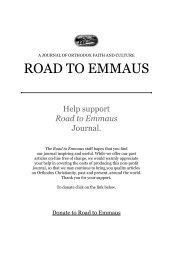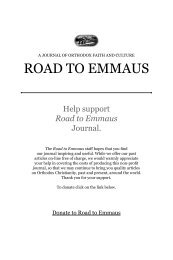RTE No 20 Interior - Road to Emmaus Journal
RTE No 20 Interior - Road to Emmaus Journal
RTE No 20 Interior - Road to Emmaus Journal
Create successful ePaper yourself
Turn your PDF publications into a flip-book with our unique Google optimized e-Paper software.
<strong>Road</strong> <strong>to</strong> <strong>Emmaus</strong> Vol. VIII, <strong>No</strong>. 4 (#31)FAITH UNSEENThere were several steps <strong>to</strong> arranging a marriage in Kromni. The first wasthe Aaeman, the “Finding,” when a young man’s parents looked for theright girl, or rather, for the right family from which they wished <strong>to</strong> take abride. Once the prospective bride was found, the family sent the localmatchmakers, who were expert in these affairs, <strong>to</strong> the family of the girl witha Psalapheman (the Proposal or Request). If the girl’s parents were in favorof the match, then negotiations for the dowry would proceed. If they wereunfavorably disposed <strong>to</strong> the proposal, the boy’s parents would almostalways abandon their suit immediately <strong>to</strong> save face. If there was a verystrong reason <strong>to</strong> acquire this particular girl as a bride, she could be abducted(the Syrsimo), and then the marriage would have <strong>to</strong> take place, but thiswas rare. The dowry was usually money, land, or household gifts given <strong>to</strong>the groom’s family by the family of the bride, as the bride would go <strong>to</strong> livewith her husband’s parents. (The Turks did the opposite, where the dowrywas “paid” by the groom’s family <strong>to</strong> the bride’s father, depending on hersocial status and accomplishments.)There were rare cases when a young man fell in love with a girl whom hemanaged <strong>to</strong> see with her face uncovered, usually at the spring where thegirls drew water. Seeing her unveiled demanded a proposal. Because of thestrict social traditions, if the young man’s parents were against the match,the following happened: respected older village women <strong>to</strong>ok the girl <strong>to</strong> visitthe groom’s house. After some time they left, leaving the girl there, and said,I níphe ekatsen ka (“The bride has sat there”). This was an extreme attempt<strong>to</strong> change the mind of the groom’s parents, and there was not a single caseof parents-in-law sending away a bride who had “sat” in their house. Itwould have been considered a great sin, completely socially unacceptable,and might even have been dangerous if their son decided <strong>to</strong> do somethingrash because he couldn’t live without this girl. When the níphe ekatsen ka,the wedding soon followed.After the girl’s parents accepted the proposal, the Soumademan 7(Betrothal or Engagement) followed. The Soumademan always <strong>to</strong>ok placeat night in the girl’s house. The young man, the parents of both couples, perhapsa few other relatives, and the priest gathered <strong>to</strong>gether – everyoneexcept the bride, who waited in another room. The young man, his parents,and the priest <strong>to</strong>ok the gold or silver rings (depending on the prosperity ofthe family) and said three times: “In the name of God and with the blessing7 Soumademan: from a Pontian Greek word used by foresters <strong>to</strong> mark trees they had selected <strong>to</strong> harvest.of the parents, we have come <strong>to</strong> engage (the groom’s name) with (the bride’sname), what do you say?” The groom responded, “Let it happen with theblessing of the God and by the wish of the parents.” The girl’s relatives thenwent with the priest <strong>to</strong> the girl, so that the priest could hear her answer aswell. The girl’s response was, “As my parents wish,” and she kissed thepriest’s hand. The priest blessed her and, rejoining the groom’s family, “gavethem” the bride, wishing them ogourlia and gatemlia (good fortune andhappiness) according <strong>to</strong> God’s Will. The family then gave the wrapped weddingrings <strong>to</strong> the priest, who blessed them and finished the betrothal servicevested in his epitrachelion. In those years, the betrothal or engagement wasdone separately, not as part of the wedding service as it is in our time.During the period of engagement, the groom never met the bride on hisown. He rarely visited her home, but when he did, he was accompanied byhis family. It was considered a shame for him <strong>to</strong> come on his own. About thisperiod there is a Turkish saying: Eniste tatli tatli gel, “the groom comessweetly,” (that is, hardly at all). Visits were much more common betweenthe parents of the betrothed than the couple themselves.The wedding, called the Stephanoma (the Crowning) was the most sacredmoment. Preparations for the wedding lasted several days and were a time ofgreat joy. The groom underwent a ceremonial shaving, and in his yard theydecorated a goat, which would escort his friends and relatives <strong>to</strong> the wedding.The bridal bath always <strong>to</strong>ok place on a Saturday, as marriages were only heldon Sunday. After the bath, the bride was enclosed in the bridal room (the basoda), where the following day she was dressed in her wedding finery, includingthe pink zoupouna, a close-fitting sleeveless jacket, like a jerkin.The Crowning was performed by the priest, <strong>to</strong>gether with the koumbaros,the best man. In our days, after the reading of the Epistle and the Gospel,the priest offers a cup of blessed (but unconsecrated) wine for the couple <strong>to</strong>drink from. In those years, the cryp<strong>to</strong>-Christian priest offered meligalainstead of wine, milk mixed with honey, which the priest mixed and blessedon the spot saying three times: “change this <strong>to</strong> that.” Those looking on wouldchant, “I will receive from this redeeming cup and I will call on the name ofthe Lord.” After the bride and groom drank from the common cup, the cupwas broken underfoot by the priest.As the couple circled the analogion with the icons and Gospel during the“Dance of Isaiah,” the priest held the hand of the best man, the koumbarosheld the hand of the négamon (groom) and the négamon held the hand of<strong>20</strong>21










